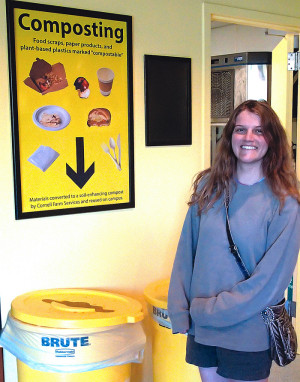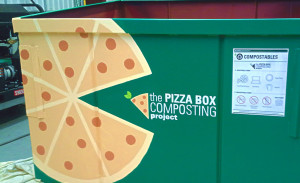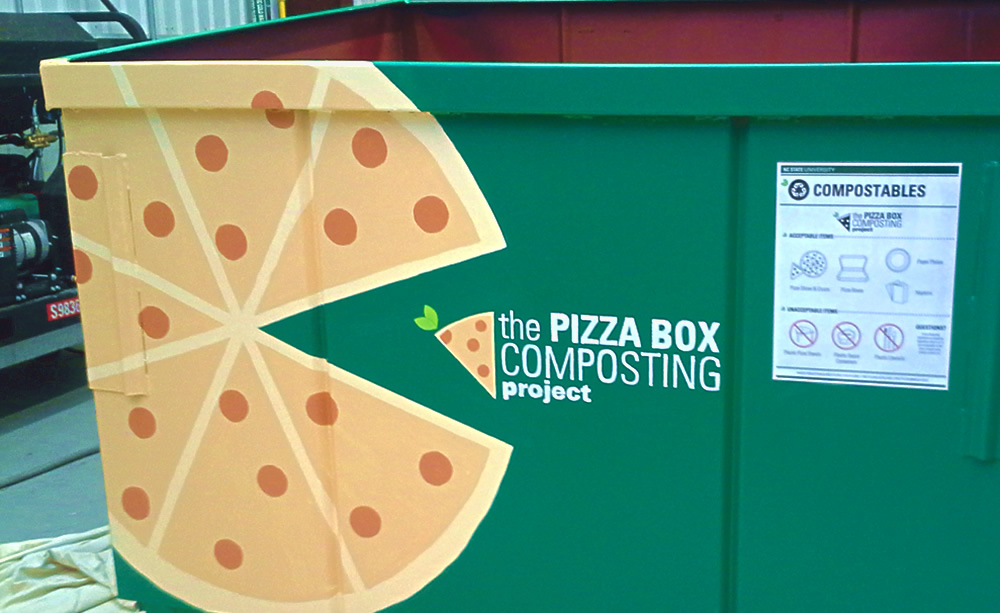BioCycle May 2014
Ithaca, New York: Cornell Food Scraps Collection Monitoring Pilot Study
Cornell University, an Ivy League institution in Ithaca, has over 20,000 undergraduate and graduate students. Food scraps diversion programs have been in place at all of the Cornell Dining units since 2007, as well as at major on-campus events since 2010. All organics are hauled to the Cornell University Agricultural Experiment Station (CUAES) composting facility less than a mile away for processing. Tri-sort receptacles in the dining halls (organics, recycling, trash) are used, and food scraps, paper products, and compostable products are accepted. Early on, CUAES Farm Services staff began noticing excessive inorganic contaminants in the source separated loads being collecting from the dining halls, resulting in rejection of loads and subsequent disposal in the Seneca Meadows Regional Landfill. To attempt to remedy the contamination woes, Claire Siegrist, a Cornell undergraduate Natural Resources Planning and Management major who is also one of three Student Sustainability Coordinators with Cornell Dining, developed and carried out a pilot study during the Spring 2014 semester to analyze the impact that monitoring collection bins would have on reducing contaminants in the organics stream.
 Monitoring waste receptacles is a common practice at Cornell’s large-crowd events like homecoming and the end-of-the-year “Slope Day” concert, so it was not a huge leap when Siegrist revamped the strategy for reducing contamination in the dining halls. “We wanted to monitor in one location, and see if we could educate people on source separation,” she explains. “Trillium Dining Hall, the location we chose, happens to be one of the most populated dining halls due to its central location on campus. We reached out to sustainability clubs and other interested groups and individuals on campus to recruit volunteers to monitor.”
Monitoring waste receptacles is a common practice at Cornell’s large-crowd events like homecoming and the end-of-the-year “Slope Day” concert, so it was not a huge leap when Siegrist revamped the strategy for reducing contamination in the dining halls. “We wanted to monitor in one location, and see if we could educate people on source separation,” she explains. “Trillium Dining Hall, the location we chose, happens to be one of the most populated dining halls due to its central location on campus. We reached out to sustainability clubs and other interested groups and individuals on campus to recruit volunteers to monitor.”
CU Compost, a club at Cornell dedicated to compost education and outreach, took an interest in the project and offered their assistance to expand the program and help with logistics. “Together, we held multiple training sessions this spring semester, where we taught students how to source separate and encouraged them to teach their friends and so on,” adds Siegrist. “In total, we trained about 150 students.” A monitoring schedule helped maximize the periods of time that collection bins were staffed.
Before any active monitoring began, they observed students’ behavior at collection bins to get a baseline understanding for what happens when students encounter the tri-sort system. “We have signage that teaches students what materials can and cannot be composted,” she adds. “After our observations, we realized people don’t look at these signs. This gave us even more reason to try active monitoring as an approach to reduce contamination.”
While the pilot did have a positive impact at reducing contamination — providing source separation enlightenment to some — monitoring is not a silver bullet, according to Siegrist. “When monitors are there, which is unfortunately not every day of the week or throughout a whole dining period, we generate clean compostables and clean recycling, which has been confirmed by the Farm Services staff that collect and haul the material. The best monitoring experience I have had is when a student with no knowledge of source separation walks up with a full tray and I have to take them through the process of where each item goes, and why it goes there. The student will reply, ‘Wow, I didn’t know you were supposed to separate those things.’” However, guidance from monitors can create an opposite effect. “It can confuse people,” she adds. “When students finish eating, they tend to be in a rush. Sometimes these students become overwhelmed and frustrated by our instructions and the tri-sort method. This can result in the student throwing all of their items in one bin, likely the compostables bin — which is exactly what we don’t want!”
Although the monitoring pilot did not completely resolve the contamination issue, it provided insight into why students aren’t source separating, and potential strategies to address the situation. While a lack of education about source separation is a factor, “the more pressing issue is a lack of concern for why we are doing this,” notes Siegrist. “Students’ lack of effort to learn how to sort properly is the major issue.” She is a member of a group that has drafted a proposal to require all incoming students to complete an online sustainability module explaining common environmental practices on campus, like source separation and using a refillable water bottle. This strategy would encourage students to buy into these behaviors before ever stepping foot on campus.
Raleigh, North Carolina: NCSU Pizza Box Composting
Until recently, composting at North Carolina State University (NCSU) was mostly behind the scenes. “We collect food waste in our dining halls but students don’t really see it because it’s all done in the kitchen out of site,” says Lauren McKinnis, Outreach Coordinator at NCSU’s Waste Reduction and Recycling Office (WRR). Concerns about contamination, however, prevented a full-fledged food waste collection program beyond the dining halls. A survey of pizza purchases from 2012-2013 indicated that NCSU on-campus programs alone purchased 2,588 pizzas. This prompted WRR to start a pizza box composting program to help NCSU achieve its goal of diverting 60 percent of campus waste by 2015. “I’m sure we will look to expanding in the future but we decided to start small to make sure it wouldn’t just become full of contaminants,” says McKinnis of the decision to focus on pizzas.
 Since the pizza program launched on March 1, 2014, about 750 boxes have been collected with minimal contamination. “So far we haven’t noticed too many issues with contamination,” she adds. In addition to pizza boxes, students can put dirty napkins, crust and paper plates in designated dumpsters outside of residence halls with historically high pizza consumption. The dumpsters, designed by a NCSU student, are decorated with a pizza slice and painted bright green to clearly indicate to students where their pizza waste should go.
Since the pizza program launched on March 1, 2014, about 750 boxes have been collected with minimal contamination. “So far we haven’t noticed too many issues with contamination,” she adds. In addition to pizza boxes, students can put dirty napkins, crust and paper plates in designated dumpsters outside of residence halls with historically high pizza consumption. The dumpsters, designed by a NCSU student, are decorated with a pizza slice and painted bright green to clearly indicate to students where their pizza waste should go.
The dumpsters are serviced weekly, with material hauled to Brooks Contractor, a composting facility located approximately 40 miles away from campus. “It’s a distance but it is the only available composter in our area and run by a NCSU alumni,” notes McKinnis. Brooks Contractor then composts the pizza boxes with green waste and food waste.
WRR has relied on student involvement to operate the pizza box composting program, from implementation to marketing strategies aimed at increasing student participation. A kickoff pizza party was held in one of the resident halls and soon a video will be produced to bring awareness to the program. In addition to pizza box and dining hall food waste composting, NCSU also offers oil and grease collection from on-campus apartments for use in production of biodiesel.
Lambertville, New Jersey: Food Scraps Collection Pilot: “Third Can”
Lambertville, a town of 3,900 residents located on the banks of the Delaware River, is known for its fun shops and wide selection of dining establishments. Now this quaint community will be recognized for something else: joining the few New Jersey municipalities offering curbside collection of separated organics. Over the past few years, much of the focus of the city’s Environmental Commission (EC) has been on expanding the city’s recycling program, specifically targeting the organic waste stream and food residuals, explains Julie Hajdusek, who serves on the EC. In 2013, Lambertville reached its highest recycling rate (982.46 tons of material), but diverting organics would greatly increase that number. In Spring 2013, the EC considered preparing a grant proposal to the NJLM Educational Foundation for Sustainable Jersey Small Grants to study the feasibility of a food waste recycling pilot. About the same time, Lambertville Councilwoman Beth Asaro heard a radio commentary on the Princeton, New Jersey, food scraps curbside collection pilot, and contacted Hajdusek to inquire about establishing a collection program in Lambertville.
 With the overwhelming support of Councilwoman Asaro, Mayor David DelVecchio and other city officials, Hajdusek prepared and the City was awarded a $10,000 grant, opening the door for the pilot study. “I wrote the grant with three items in it: 1) Gauge interest in a curbside food scraps collection program; 2) Study the feasibility of constructing anaerobic digesters at the Lambertville Wastewater Treatment Plant to create biogas from biosolids and food waste; and 3) Establish Lambertville as a model for small communities that want to establish organics diversion programs by keeping track of the pilot process and progress through the city’s website,” Hajdusek explains. The EC worked with Asaro to develop an online survey to assess interest in a food scraps collection pilot among the Lambertville community. The survey received 300 responses, or just below 10 percent of the town’s total population. Significant findings included: 81.6 percent indicated interest in curbside collection of organic waste; 90.4 percent said they wanted to reduce the amount of garbage they produced weekly; and 50 percent (149 people) expressed interest in being part of a pilot program. These results gave city staff confidence to move forward with the collection pilot, which they have appropriately named “Third Can,” for the third waste receptacle participating residents receive.
With the overwhelming support of Councilwoman Asaro, Mayor David DelVecchio and other city officials, Hajdusek prepared and the City was awarded a $10,000 grant, opening the door for the pilot study. “I wrote the grant with three items in it: 1) Gauge interest in a curbside food scraps collection program; 2) Study the feasibility of constructing anaerobic digesters at the Lambertville Wastewater Treatment Plant to create biogas from biosolids and food waste; and 3) Establish Lambertville as a model for small communities that want to establish organics diversion programs by keeping track of the pilot process and progress through the city’s website,” Hajdusek explains. The EC worked with Asaro to develop an online survey to assess interest in a food scraps collection pilot among the Lambertville community. The survey received 300 responses, or just below 10 percent of the town’s total population. Significant findings included: 81.6 percent indicated interest in curbside collection of organic waste; 90.4 percent said they wanted to reduce the amount of garbage they produced weekly; and 50 percent (149 people) expressed interest in being part of a pilot program. These results gave city staff confidence to move forward with the collection pilot, which they have appropriately named “Third Can,” for the third waste receptacle participating residents receive.
The pilot is set to begin on May 11, and will run for one year. Registration is limited to 100 households, with priority given to citizens that filled out the City’s survey. Participating residents pay $65 and in return receive: a 3-gallon kitchen countertop container with compostable BioBags; a 32-gallon curbside container; weekly curbside collection of organics; troubleshooting support; and free compost three times/year. The fee is a subsidized rate, offset by grant funds to keep the cost reasonable for participants. City staff will haul all collected organics to the AgChoice composting facility in Sussex County. “The City is administering the program and the EC is playing more of an advisory role,” Hajdusek notes. “We’d also like to expand the program into local restaurants and the Lambertville Public School over the coming months.” She adds that the curbside collection pilot will be evaluated based on two major factors: 1) Reduction in tonnage of trash sent to the landfill, and the corresponding financial savings; and 2) Cost-benefit analysis of converting the municipal wastewater treatment plant to a facility capable of processing food waste through newly constructed anaerobic digesters.

Moorefield, West Virginia: Biosolids Composting Underway
Biosolids composting at the Moorefield Hardy County Wastewater Authority got underway in March. The facility is using the GORE® system to produce a Class A compost. The site is capable of handling 30 tons/day of biosolids mixed with bulking material, such as yard trimmings and wood waste. It was built as part of a new treatment plant designed to process around 4.1 million gallons/day of wastewater. The Town of Moorefield has around 2,500 residents, but a food processing facility nearby also sends industrial wastewater to the plant equivalent to the volume produced by around 50,000 people. Prior to completion of the facility in November 2013, biosolids from Moorefield were primarily land-applied and occasionally landfilled. “When we were considering how to handle biosolids in the design of the new plant, the engineers found it would be less expensive to compost than landfill due to hauling costs,” says Lucas Gagnon, President of the Moorefield Hardy County Wastewater Treatment Authority. “Plus we know it’s the right thing to do from a green perspective.” The GORE system was the most affordable option when labor and equipment were considered. The authority anticipates a 5-year return on its investment.
Dewatered biosolids are initially mixed in a Rotomixer with three parts shredded wood to one part biosolids. Compost piles, built with a front-end loader, are 26-feet wide at the base,
12-feet high and 100-feet long. Piles remain under cover for four weeks, are uncovered and turned, covered again for two weeks, then turned a final time before curing uncovered for two additional weeks. Finished compost is screened with a Wildcat trommel; overs are reused as bulking material. Around 10,000 tons of compost will be produced annually. Gagnon expects to sell the compost to commercial customers, including a large mulch company that provides the bulking agent for biosolids composting. “We are also hoping to make the product available to the community,” he adds.
St. Mary’s City, Maryland: College Expands Into Food Scraps Composting
Composting at St. Mary’s College is on the rise. Until recently, the small liberal arts campus was limited to yard trimmings composting managed by grounds maintenance staff. That all changed when Jennifer Walker, St. Mary’s Sustainability Fellow, took charge. “At first it was just me,” notes Walker. “I collected everything on weekends. But once I showed people how it could be done it caught on.” Now, Walker has three paid interns who collect food waste (excluding meats) weekly in 5-gallon buckets from campus residential halls, academic buildings and a nearby church. Filled buckets are transported in a pickup truck to the campus farm located about a quarter-mile away. In addition, food waste from the dining hall is collected daily.
At the farm, incoming organics are placed in a large pile then incorporated into approximately seven piles used for active composting. Green waste from grounds maintenance and the farm are added to the piles, which are turned by hand. In addition to the compost interns, student volunteers and staff assist with managing the compost piles. Walker estimates the process takes about six months before the compost is applied to campus landscapes or vegetable beds at the farm.
The college’s organic farm itself provides educational opportunities for both students and the community to learn about farming. Small plots are allotted to anyone who would like one. It is also a classroom for a campus sponsored gardening class. Some produce is sold at farmers markets and used in the campus dining hall. Nearly a year into the composting program, Walker hopes to increase participation and ensure the program will continue to operate year to year when her term as a fellow expires. She also sees potential for the program to accept feedstocks from the community and in turn provide them with compost.
Austin, Texas: Volunteer network Boosts Composting
While the City of Austin pilots curbside collection of food scraps to support its goal of 90 percent waste reduction by 2040, some residents and businesses are partnering to collect and compost organics in Austin backyards and at schools and community gardens. Compost Coalition, a volunteer network, connects these organics to users as well as provides information to generators of organic waste and community composters. According to Heather-Nicole Hoffman, founding member, the Compost Coalition began in 2011, when a customer asked a Whole Foods produce manager what became of blemished produce. It turned out that the Whole Foods was already composting its organics, but the exchange highlighted the potential to collect organics from generators and supply local composters with added feedstocks. The group decided to focus on connecting small generators with home composters. Eventually coffee shops became the focal point as part of the Ground to Ground project affiliated with the Compost Coalition.
Ground to Ground, modeled after the Australian program of the same name, has been the Compost Coalition’s most successful project thus far, says Hoffman. It started in September 2012 with only five participating businesses, but quickly grew to over 25 businesses within a few months. This was largely due to the work of volunteers, especially participating Master Gardeners. Approximately nine tons of organics, primarily coffee grounds, are diverted each month through the program.
The Compost Coalition also connects composters with other feedstock sources such as wood chips, yard trimmings and kitchen scraps. It also helps chicken owners find food sources such as spent grain, dairy and meat products. The Coalition’s website includes maps directing those interested to sources of compostables. The program relies solely on volunteers and has received no fiscal or legal assistance from outside resources. AgriLife, a Texas A&M affiliated county extension, and Urban Patchwork, an organization promoting urban farming, have helped the Compost Coalition recruit volunteers and leverage their outreach. “We are really trying to promote ‘You live here, you compost here,’” explains Hoffman. “There are plenty of materials out there, we just need more people recognizing that they are resources and not waste and more people taking advantage of those resources.”












